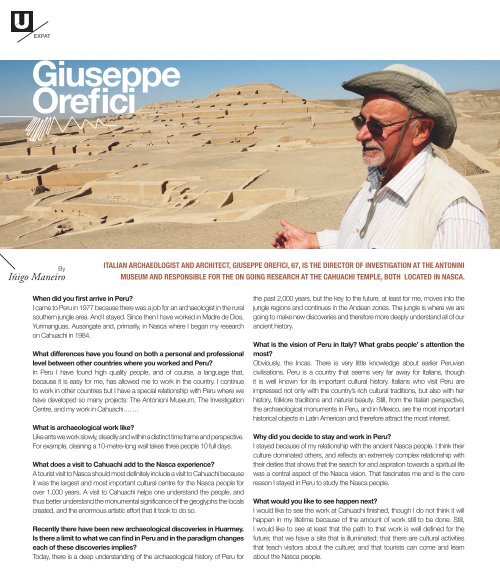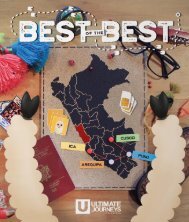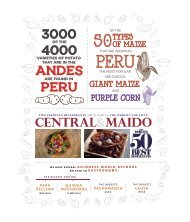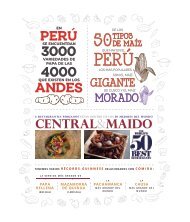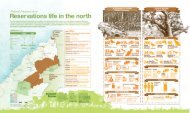UJ#5 Paracas
You also want an ePaper? Increase the reach of your titles
YUMPU automatically turns print PDFs into web optimized ePapers that Google loves.
EXPAT<br />
Giuseppe<br />
Orefici<br />
By<br />
Iñigo Maneiro<br />
ITALIAN ARCHAEOLOGIST AND ARCHITECT, GIUSEPPE OREFICI, 67, IS THE DIRECTOR OF INVESTIGATION AT THE ANTONINI<br />
MUSEUM AND RESPONSIBLE FOR THE ON GOING RESEARCH AT THE CAHUACHI TEMPLE, BOTH LOCATED IN NASCA.<br />
When did you first arrive in Peru?<br />
I came to Peru in 1977 because there was a job for an archaeologist in the rural<br />
southern jungle area. And I stayed. Since then I have worked in Madre de Dios,<br />
Yurimanguas, Ausangate and, primarily, in Nasca where I began my research<br />
on Cahuachi in 1984.<br />
What differences have you found on both a personal and professional<br />
level between other countries where you worked and Peru?<br />
In Peru I have found high quality people, and of course, a language that,<br />
because it is easy for me, has allowed me to work in the country. I continue<br />
to work in other countries but I have a special relationship with Peru where we<br />
have developed so many projects: The Antonioni Museum, The Investigation<br />
Centre, and my work in Cahuachi…….<br />
What is archaeological work like?<br />
Like ants we work slowly, steadily and within a distinct time frame and perspective.<br />
For example, cleaning a 10-metre-long wall takes three people 10 full days.<br />
What does a visit to Cahuachi add to the Nasca experience?<br />
A tourist visit to Nasca should most definitely include a visit to Cahuachi because<br />
it was the largest and most important cultural centre for the Nasca people for<br />
over 1,000 years. A visit to Cahuachi helps one understand the people, and<br />
thus better understand the monumental significance of the geoglyphs the locals<br />
created, and the enormous artistic effort that it took to do so.<br />
Recently there have been new archaeological discoveries in Huarmey.<br />
Is there a limit to what we can find in Peru and in the paradigm changes<br />
each of these discoveries implies?<br />
Today, there is a deep understanding of the archaeological history of Peru for<br />
the past 2,000 years, but the key to the future, at least for me, moves into the<br />
jungle regions and continues in the Andean zones. The jungle is where we are<br />
going to make new discoveries and therefore more deeply understand all of our<br />
ancient history.<br />
What is the vision of Peru in Italy? What grabs people’ s attention the<br />
most?<br />
Obviously, the Incas. There is very little knowledge about earlier Peruvian<br />
civilisations. Peru is a country that seems very far away for Italians, though<br />
it is well known for its important cultural history. Italians who visit Peru are<br />
impressed not only with the country’s rich cultural traditions, but also with her<br />
history, folklore traditions and natural beauty. Still, from the Italian perspective,<br />
the archaeological monuments in Peru, and in Mexico, are the most important<br />
historical objects in Latin American and therefore attract the most interest.<br />
Why did you decide to stay and work in Peru?<br />
I stayed because of my relationship with the ancient Nasca people. I think their<br />
culture dominated others, and reflects an extremely complex relationship with<br />
their deities that shows that the search for and aspiration towards a spiritual life<br />
was a central aspect of the Nasca vision. That fascinates me and is the core<br />
reason I stayed in Peru to study the Nasca people.<br />
What would you like to see happen next?<br />
I would like to see the work at Cahuachi finished, though I do not think it will<br />
happen in my lifetime because of the amount of work still to be done. Still,<br />
I would like to see at least that the path to that work is well defined for the<br />
future; that we have a site that is illuminated; that there are cultural activities<br />
that teach visitors about the culture; and that tourists can come and learn<br />
about the Nasca people.


